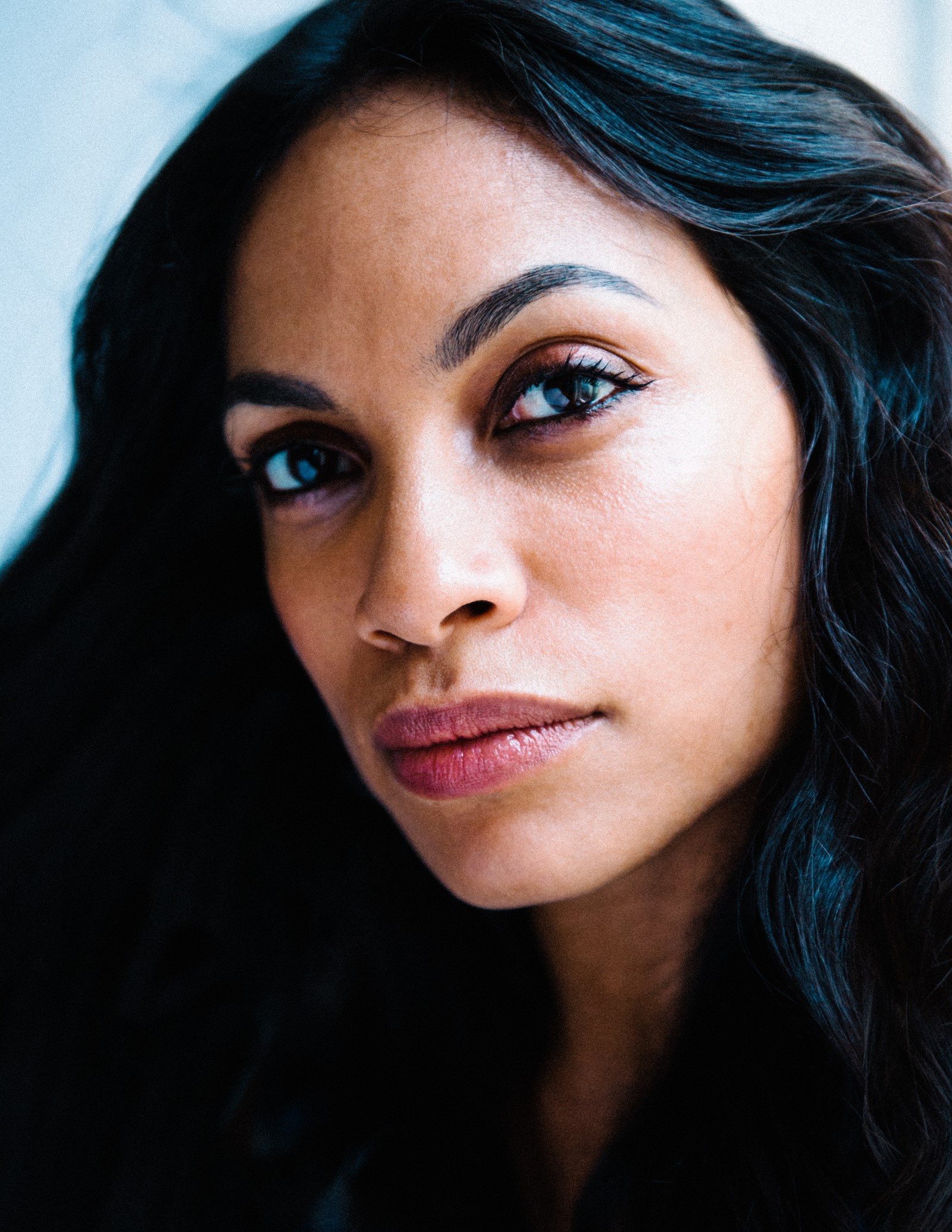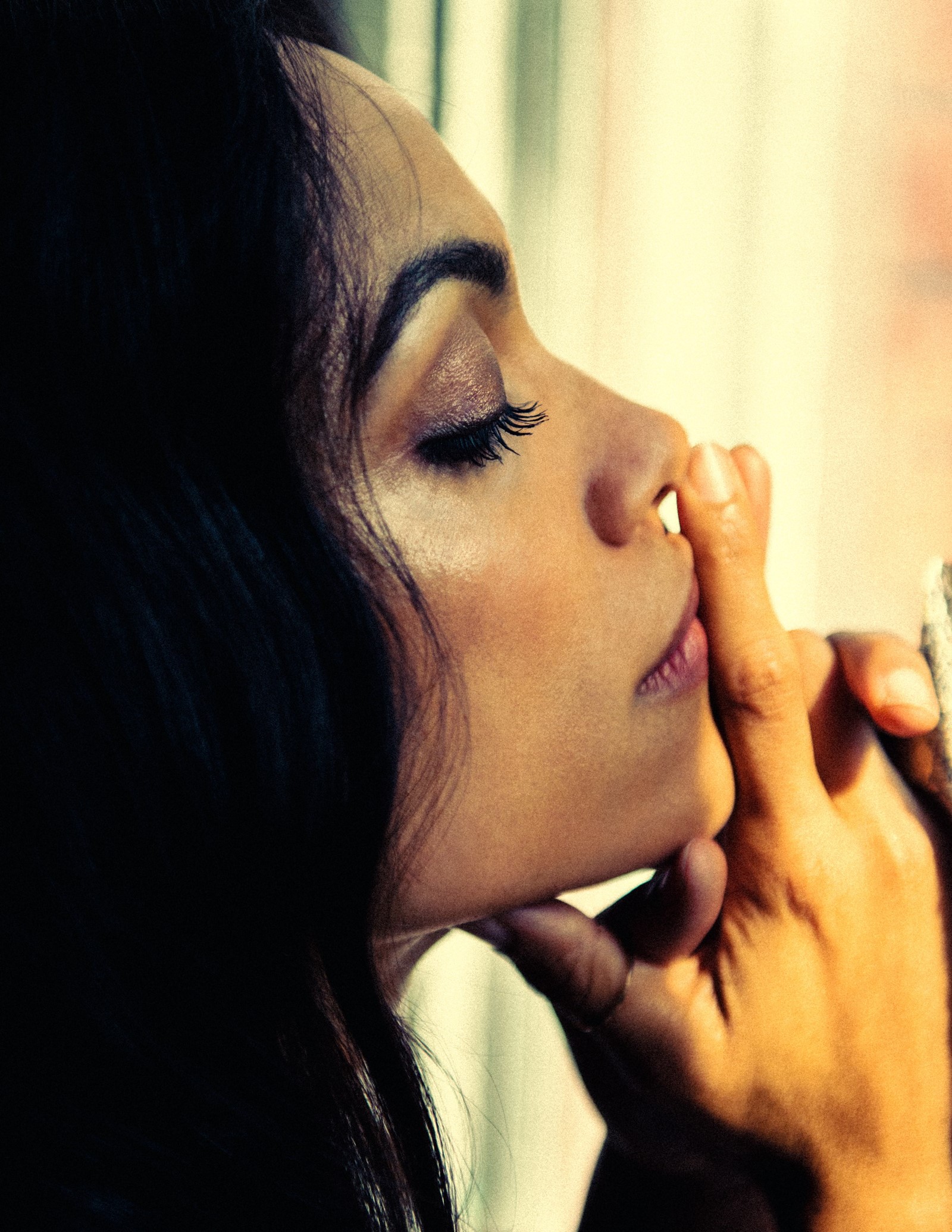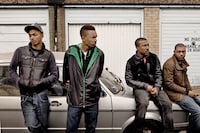“I met Rosario Dawson on an airplane in North Carolina. I was sitting in my seat listening to music when a gentle hand tapped me on my shoulder. I turned, thinking it was the flight attendant scolding me for not putting on my seat belt, and was pleasantly surprised when it turned out to be Rosario Dawson. ‘I just want to tell you I’m a fan of yours and I’m enjoying everything you’re putting out in this world, thank you,’ she said. Of course I know Rosario Dawson, she is one of the most iconic actresses of my generation. While she was a teenage actress, I and so many others would liken ourselves to the little sisters or brothers watching her on the big screen, wondering when if ever we could or would be that cool, that elegant, that sexy. Fast forward to the present, and I am just as awed with Rosario’s activism and social justice work as I am by her film credits and stand-out movie roles. It is always a pleasure to be in her company!” – Mykki Blanco, guest editor of Dazed, August 2018
Stumbling past the fast-money bridge and tunnel crowd queued up outside East Village watering holes like The Phoenix or Ace Bar today is nothing like it was in the 70s. Back then, Debbie Harry trod the needle-paved streets trying to hail a cab, convinced that one time she was given a lift by serial killer Ted Bundy. The Velvet Underground performed “The Exploding Plastic Inevitable”, the house band at Warhol-run discotheque Electric Circus. Pre-gentrification East Village – before the death of St. Mark’s Place and half-decent one dollar pizza slices – was home to Rosario Dawson.
After being discovered on her front porch by Harmony Korine and Larry Clark in the 90s, Dawson played Ruby in Larry Clark’s Kids. You might know her as Valerie Brown in Josie and the Pussycats, Mimi in the 2005 film adaptation of Rent, doctor Claire Temple in any iteration of a Marvel series on Netflix (Luke Cage, The Defenders), or most recently as the powerful lesbian lawyer Jane Ramos on Jane The Virgin. Since being spotted on her East Village stoop, Dawson has carved a varied and often surprising path through Hollywood – but has never forgotten her roots in the process.
The actor once lived in a squat on 13th Street, now home to Momofuku and Milk Bar. There was no running water, heat or electricity. There was an elevator shaft with no working elevator. There was a hole that took up much of the floor space. The basement stairwell was soaked in urine. Plastic covered the windows. Plywood acted as a door. An empty hot tub sat in her living room.
“Because my parents worked in construction, we would get these recycled pieces that would have otherwise been thrown in the garbage,” Dawson explains of her scrappy childhood over the phone from LA. “So we had this big hot tub that wasn't outfitted with anything, it was just sitting there with plastic over the holes. It was just quirky and weird; our neighbour Jean was an artist and had a swing, and everybody made do. We had block parties. There was just an incredible mixture of art and resistance and radicalism and off-the-gridding.”
It was Dawson’s metropolitan answer to Winona Ryder’s California commune upbringing, or River Phoenix’s bohemian rearing in the Children of God cult. But hers was less choice, more necessity. More than that, it was all she knew. “When you're younger, it’s so hard to differentiate between why spaces are different, but all the kids I went to school with didn't have very much, so we were all in the same boat. My parents just did it a little differently than theirs did.”

Dawson, 39, has seen the East Village change hands from the squatters, who initially fought off gentrification (“The squatters were fighting back with rocks and a tank came down 13th Street, and helicopters were going – as a teen, I remember getting a taste of that”) to the high-heeled Sunday brunch zombies it has since become. While she’s happy she no longer has to dodge syringes walking down Avenue A, she does lament its lack of culture. “Yeah I want to have safety and I want the fire department or the police to come when you need them, but also, where are all the tattoo-faced people? Where does that go?”
As a 15-year-old, it was on that street that Dawson was scouted for her career-making role in Larry Clark’s cinematic molotov cocktail, Kids. To set the scene, a commercial for Vibe was being shot outside her parents’ apartment. The motivation for her discovery was two-fold: Dawson fancied one of the grips on that set, and her father wanted her to get discovered. So she camped out on the stoop waiting for action, throwing him flirty looks like Mercy in The Warriors.
“Yeah I want to have safety and I want the fire department or the police to come when you need them, but also, where are all the tattoo-faced people?” – Rosario Dawson
The grip, flowing hair, sharp blue eyes, eventually came over to ask if there were any free spaces in their squat that could be used for filming. “I couldn't really hear what he was saying, and I started laughing to myself because I thought, this guy looks like the classic depiction of Jesus, you know? I started guffawing because I was like, ‘I'm humouring Jesus’. They were shooting sounds that day on the commercial and this whole group of people suddenly turned and looked at me and I thought I was in trouble, and it ended up being a pre-production group from Kids that were scouting for locations.”
She was approached and tag-teamed by director Larry Clark and the film’s 19-year-old writer, a hyperactive Harmony Korine, to come and audition for the role of Ruby. “Larry said he was making his first movie and would I be interested. And Harmony was jumping up and down, like, ‘Oh my God, I wrote this character for you without even realising. I didn't even know you. You're perfect for this character, you have to come in. You have to come in, you have to come in.’”
It turned out he was correct. She was perfect for it. Her turn as Ruby, opposite Chloë Sevigny’s HIV-positive rape victim Jennie, was sensational, and Dawson has since gone on to become arguably the most successful of that film’s cast. (To boot, she ended up in the Vibe commercial as a backup dancer. She has never seen it.) Despite Kids’ desultory plot, Dawson stood out. She was awarded $1000 for her four days on set. The money was usurped by her family for a vacation to Texas to visit her father’s extended family. They decided upon a move to Texas, and Dawson didn’t give a second thought to a career as an actress, until Clark once again came calling to fly her out to New York for a Harper’s Bazaar photoshoot as a model. “Had I disappeared into Texas and not been called back, I wouldn’t have known.”
“Harmony was jumping up and down, like, ‘Oh my God, I wrote this character for you without even realising. I didn't even know you. You're perfect for this character, you have to come in” – Rosario Dawson
Born out of an environment of urban chaos to a teenage mother before being transported into the shellacked veneer of Hollywood, Dawson holds the issue of East Village gentrification close to her heart. “There's gentrification happening everywhere, but there’s gotta be someone to do something about it,” she attests. “There is an organisation in the Lower East Side called Good Old Lower East Side, and they’ve been working for 40 years now, stopping people from being kicked out of their homes. These are the people I grew up with that I look at like, they're the superheroes, the caped crusaders, the vigilantes that are going against the loopholes, the special interests, all these other systems in play to inject humanity into the process and it's really powerful and beautiful.”
Dawson has been handcuffed for her political activism, attended rallies and conventions in between takes, and doesn’t care if it loses her a job or two in the process. Her activism stretches back to when she was young. Dazed followed her to Berlin in April 2002, where aged 22 she had flown to protest the Iraq War. Apart from using her celebrity to bend the feeble arms of government bodies and corporate factions, she’s leveraging her clout to highlight those up and comers who do good work. Studio 189, for example, is a fashion collaboration between Dawson and Ghanaian Abrima Erwiah to create African-inspired clothing made in Africa. It started in 2013. Their designs have recently taken home a CFDA + Lexus Fashion* Initiative award and afforded Dawson to live out her “lifelong dream” to dance with Paula Abdul. She also co-founded Voto Latino to encourage young Latinos to exercise their constitutional right to vote. In addition to that, she says, giggling, her work with The Turtle Conservacy allows her to chill out with turtles. “I'm all down for getting arrested and being in the thick of it, but I love when it’s just like, I’m gonna hang out with this turtle for a bit – thanks.”

She couldn’t list on one hand the number of organisations she is a part of or vouches for – and she knows them all by name – nor does she see the need to. Ask her and she’ll tell you, but Dawson doesn’t wear her good deeds like a badge. She is just glad she can play witness to the change, both in the diversity of films and television and in the opinions and politics of the outside world. “For me, it’s really just the work,” she says. “That’s my way of showing that I care, that’s my way of showing up, that’s my way of exploring my curiosity, of trying new things, meeting new people…”
A few weeks ago, I heard a charming story about Dawson. The actor and philanthropist was spotted back near her former squat. It was an East Village block party. Dawson was hemmed in by topless hippies dancing and singing in the street, some on the roof of an old school bus. Her people. She exchanged a few words about the strange scene with a bystander who blurted as she left, “I loved you in Rent, by the way!” The East Village may be a cultural suckhole, but Rosario Dawson, possibly the last holdover from a golden age of creativity, on loan from bohemia, and indignant at the injustice nipping at our heels, isn’t ready to just give up and head to brunch.

